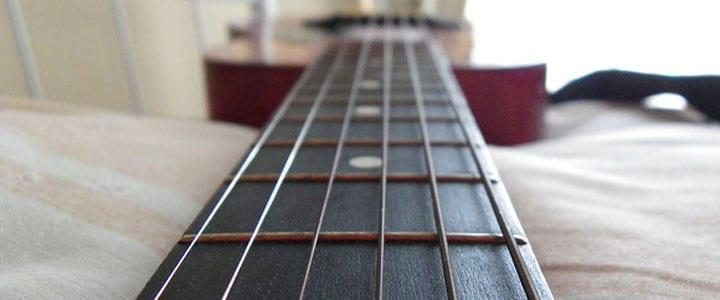 Learning how to change your guitar strings may seem daunting, but new strings can make a huge difference in the sound and intonation of your guitar. Let guitar teacher Noaa R. walk you through the process step by step…
Learning how to change your guitar strings may seem daunting, but new strings can make a huge difference in the sound and intonation of your guitar. Let guitar teacher Noaa R. walk you through the process step by step…
Changing your guitar strings is an essential maintenance skill. In addition to sounding bad, old strings are difficult to play and prone to breakage. Strings should be changed at least on a monthly basis, and more often if you can afford it. Changing them is very easy, fortunately. Here’s how:
Materials:
-New Strings
-Wire Cutter
-Needlenose Pliers
-Tuner
-String Winder (optional)
It’s best to change the strings one at a time so that the tension exerted on the neck doesn’t fluctuate too much.
Here’s the step-by-step process for how to change guitar strings:
1) Remove Dead String
Loosen the string using the tuning machine. If you have a string winder, this is much faster. Pull the end out of the tuning post and clip the bent portion. This leaves the string tip straight so that it can be easily pulled out through the bridge by the ball end. Wrap and discard. Needlenose pliers can be useful here for extraction, especially if one of your strings has broken and a curly fragment is lodged in the post of the tuning peg.
2) Insert New String
Unwrap the fresh string and insert the straight end through the appropriate hole in the bridge. With a Stratocaster-style bridge, this insertion point is accessed under the panel on the back of the guitar. On other guitars with front-mounted tailpieces, such as Les Pauls, the insertion points are found at the back of the tailpiece just behind the bridge. Pull the string all the way through until the ball end catches securely.
In most acoustic guitars, the strings are held in place by small pegs called bridge pins. You can remove them using a coin or a pick for leverage, or with special tools found in almost any music store. Feed the ball end about halfway down the peghole and insert the pin, lightly pulling up on the string until you feel it wedge snugly. The goal is to trap the ball end between the narrow tip of the peg and the wall of the cavity. If pulling on the string pops the peg out of place, start over. It takes a little practice to get the feel for this, but you’ll pick it up quickly.
3) Secure String And Tighten To Pitch
Pull the string all the way through the appropriate string post until it is taut, then pull it back out about one or two fret lengths to create some slack. Then kink it around the string post to set the length and tighten, counterclockwise, until your tuner indicates the desired pitch. A string winder speeds this process, but be careful not to overtighten as the string may snap. As the string wraps around the post, guide the protruding string end so that the coils sit nicely on top of and around it, keeping it secure. Clip the excess length from the post and discard.
4) Stretch String
The string, under tension for the first time, will naturally drop in pitch. To condition it, fret the string with one hand at the 12th fret. With the free hand, place a thumb against the guitar for leverage and use your fingers to gently pull the string up and down about an inch from the body for 15-20 seconds. The pitch will drop significantly; tune it back up to the correct note and repeat.
Be careful not to pull too vigorously, especially with the smaller strings, as you run the risk of snapping them. With each stretch, the amount of pitch correction required will decrease. When a stretch results in little to no change in the string’s pitch, you’re done. Move on to the next string and repeat the process.
5) Repeat Steps 1-4 With Remaining Strings
6) Fine Tune And Jam
Once all the strings have been changed and excess material has been discarded, give each string one more quick stretch and retune. You’re done! Enjoy the newly-rejuvenated sound of your instrument and the slick, smooth mobility of fresh strings! Now go practice!!
If you’d like one-on-one assistance learning how to change guitar strings, or help with anything else on your guitar, taking lessons with a private guitar teacher is the best way to find out what you want to know. Search for a guitar teacher near you today!

Noaa R. teaches guitar, music theory, and composition lessons in Jamaica Plain, MA. He is a current student at Berklee College of Music and he has been teaching students since 2011. Learn more about Noaa.
Photo by Catherine Singleton
Suzy S.

